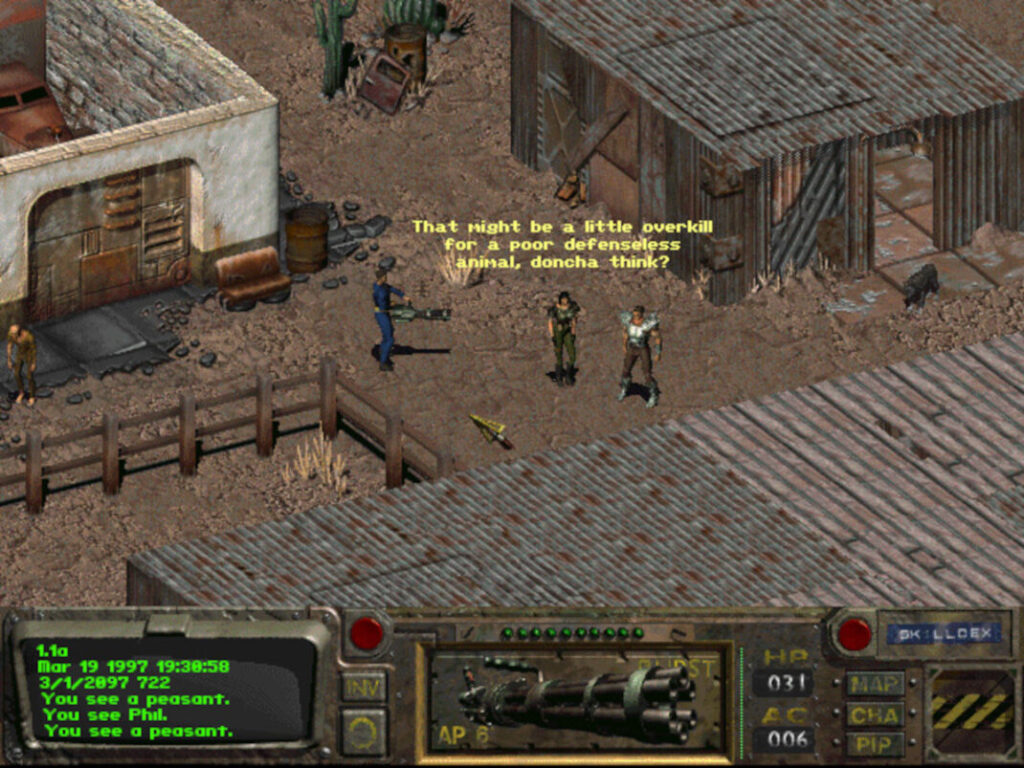What began with Fallout 1 on September 30, 1997, has now become one of the most famous video game series ever. How this came about and what development the Fallout series has gone through over the years, I would like to clarify here.

The Fallout franchise has a lot of fans. Among other things, I am one of them. Although I originally started with Fallout 3 and not one of the classics Fallout 1 & 2, I still developed a burning passion for the games. Despite the rather disappointing developments in recent years, I am not alone. The Fallout community is still active to this day and continuously busy keeping the Fallout games alive.
Fallout 1
It all began here on September 30, 1997. The first Fallout game was published by Interplay. Back then, the full title was “Fallout: A Post Nuclear Role Playing Game,” but the game was soon known only as Fallout 1. The name was often changed back then, for example one project title was “Armageddon”, but this was already assigned to another project and so it was finally agreed on Fallout.
The story of Fallout 1 forms the cornerstone for all subsequent games. As the protagonist we start in the year 2161, 84 years after the great war, in Vault 13. Vault 13 is located in Southern California. When the water chip in the vault gives up, the protagonist is tasked with looking for a new one outside of the vault. Originally there are 150 days available until the vault has used up its supplies.
But in addition to the task of securing the chip, the protagonist soon stumbles upon a new danger. “The Master” is a super mutant who wants to use pre-war technology to turn all people into super mutants. It is up to the protagonist to kill the master before he succeeds.
The game has two endings. If the player succeeds in both delivering the chip to the vault and defeating the master, he will have a happy ending. But when they return, the protagonist is banned from the vault. This is to prevent other Vault residents from doing the same and wanting to leave the Vault. Should the protagonist fail, however, the super mutants overrun Vault 13. This is the bad ending.

Fallout 2
Exactly one year after the release of “Fallout: A Post Nuclear Role Playing Game”
appears “ Fallout 2: A Post Nuclear Role Playing Game ” – on September 30, 1998. At that time the game was released by Interplay just like its predecessor.
The story of Fallout 2 picks up where Fallout 1 left off. The protagonist of the first part, which was banned from the Vault, migrates to Oregon, where he founds his own tribal village Arroyo. He disappears shortly after he has finished writing his memoir, leaving Arroyo behind. Shortly thereafter, the village is hit by a severe drought and “the Chosen One”, a direct descendant of the Vault Dweller, is tasked with finding a GECK. The dude makes it possible to turn the nuclear desert into a productive colony.
However, the player quickly realizes that something has not only happened in Arroyo. The post-apocalyptic world is changing rapidly. So a new faction was formed, which is called the “New California Republic”. Your goal is to unite people. But a new danger is looming too, the enclave. The enclave is what remains of the United States government. They are protected from radiation and their goal is to keep the human race clean.
On an oil rig, they not only keep the settlers from Arroyo prisoner, but also the human inhabitants of Vault 13. It is up to the protagonist to free everyone from captivity in the enclave. To do this, he uses an old oil tanker and travels to the oil rig on the sea.
The foundation for future Fallout games
Fallout 1 and 2 provided the foundation for all subsequent Fallout games. So newer titles not only tied to their story and took over political groups. Various game systems were also copied.
For example, the SPECIAL system was introduced in Fallout 1. In addition, the 18 basic skills that the game had were still in use in Fallout 3 and Fallout New Vegas. Overall, it has to be said that the original Fallout games may have gotten a bit old, but should not be forgotten as important elements of the game series. After all, the later game highlights would never have come about without them and Interplay.


